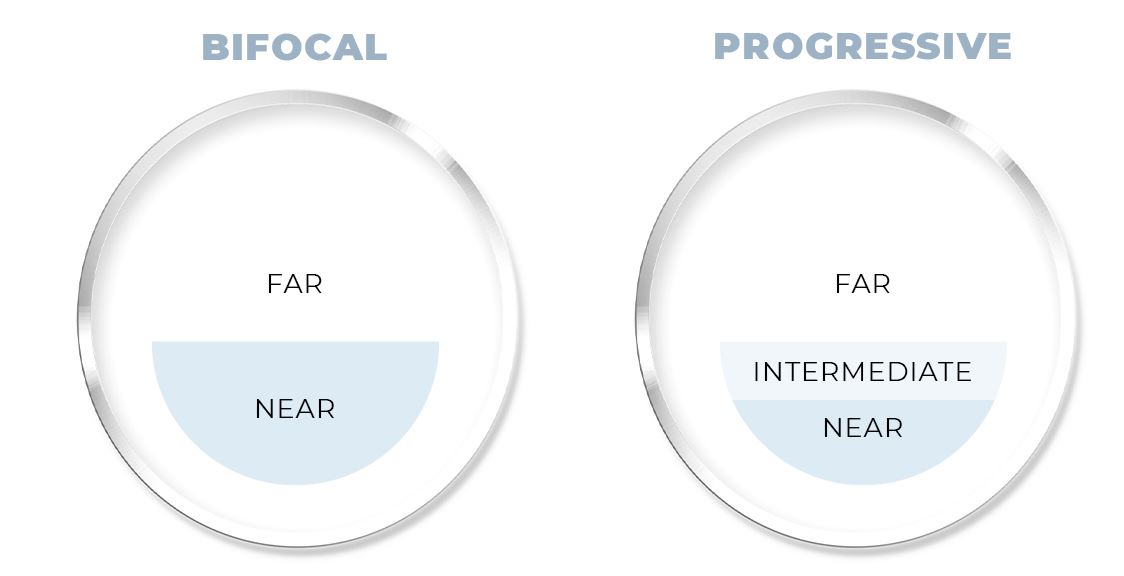Matters needing attention
①When matching glasses, the size of the frame is strictly required when selecting the frame. The width and height of the frame should be selected according to the pupil distance.
②After wearing glasses, when observing objects on both sides, you may find that the definition is reduced and the visual object is deformed, which is very normal. At this time, you need to turn your head a little and try to see from the center of the lens, and the discomfort will disappear.
③When going downstairs, glasses should be brought low as far as possible from the upper area to see out.
④Glaucoma, eye trauma, acute eye disease, hypertension, cervical spondylosis and other people are not recommended to use.
Have you heard of zooming glasses? From single-focus lenses, bifocal lenses and now progressive multifocus lenses,
Progressive multifocus lenses have been widely used in myopia control lenses for teenagers, anti-fatigue lenses for adults and progressive lenses for middle-aged and elderly people. Do you really know progressive multifocus lenses?
01 Three functional areas of progressive multifocus lenses
The first functional area is located at the upper part of the lens remote area. The remote area is the degree required to see far, used to see distant objects.
The second functional area is located near the lower edge of the lens. The proximity zone is the degree required to see close, used to see objects close.
The third functional area is the middle part that connects the two, called the gradient area, which gradually and continuously transitions from the distance to the near, so that you can use it to see middle-distance objects.
From the outside, progressive multifocus lenses are no different from regular lenses.
02 Effect of progressive multifocus lenses
① Progressive multifocus lenses are designed to provide patients with presbyopia with a natural, convenient and comfortable way of correction. Wearing progressive lenses is like using a video camera. A pair of glasses can see both far away and near, as well as middle-distance objects. So we describe progressive lenses as "zoom lenses", one pair of glasses is equivalent to multiple pairs of glasses.
② To slow down visual fatigue and control the development rate of myopia, but not all teenagers are suitable for wearing progressive multi-focus glasses, the crowd is very limited, the lens only has a certain effect on adjusting the lag with implicit oblique myopia children.
Note: As most myopia patients have external oblique rather than internal oblique, the number of people suitable for wearing progressive multi-focus glasses to control myopia is very limited, accounting for only 10% of children and adolescents myopia.
③ Progressive lenses can also be used to relieve visual fatigue for young and middle-aged people. As the backbone of the society, eye fatigue of the young and middle-aged is more and more worthy of attention. Progressive lenses can be similar to anti-fatigue lenses to relieve visual fatigue in computer users, and can also be used as transition lenses to ensure long, medium and near multi-focus vision in the future.

03 Choice of progressive multifocal glasses
Shape requirements
Avoid choosing frames with large nasal bevel because the proximal area of such frames is relatively small.
Material requirements
It is best not to choose plates and TR frames without nose pads. This is because the near-eye distance of such frames is generally too small (it should be kept at about 12mm normally), the near-eye cannot reach the position of the near-use area normally, and it is difficult to adjust the tilt Angle of glasses.
The size of the request
The vertical height corresponding to the pupil position of the frame should generally meet the requirements specified by the product, which is generally greater than or equal to the requirements of 16MM+ channel length. If there are special requirements, you must refer to the requirements of the lens to select the appropriate size of the frame.
The performance requirements
Frames with good stability should be selected to avoid frequent deformation of glasses affecting the use requirements. Glasses can be kept at an Angle of 10 to 15 degrees. The curved face of the frame should conform to the contours of the wearer's face. The length, radian and tightness of the mirror are suitable for normal wear.
Post time: Jul-20-2022
